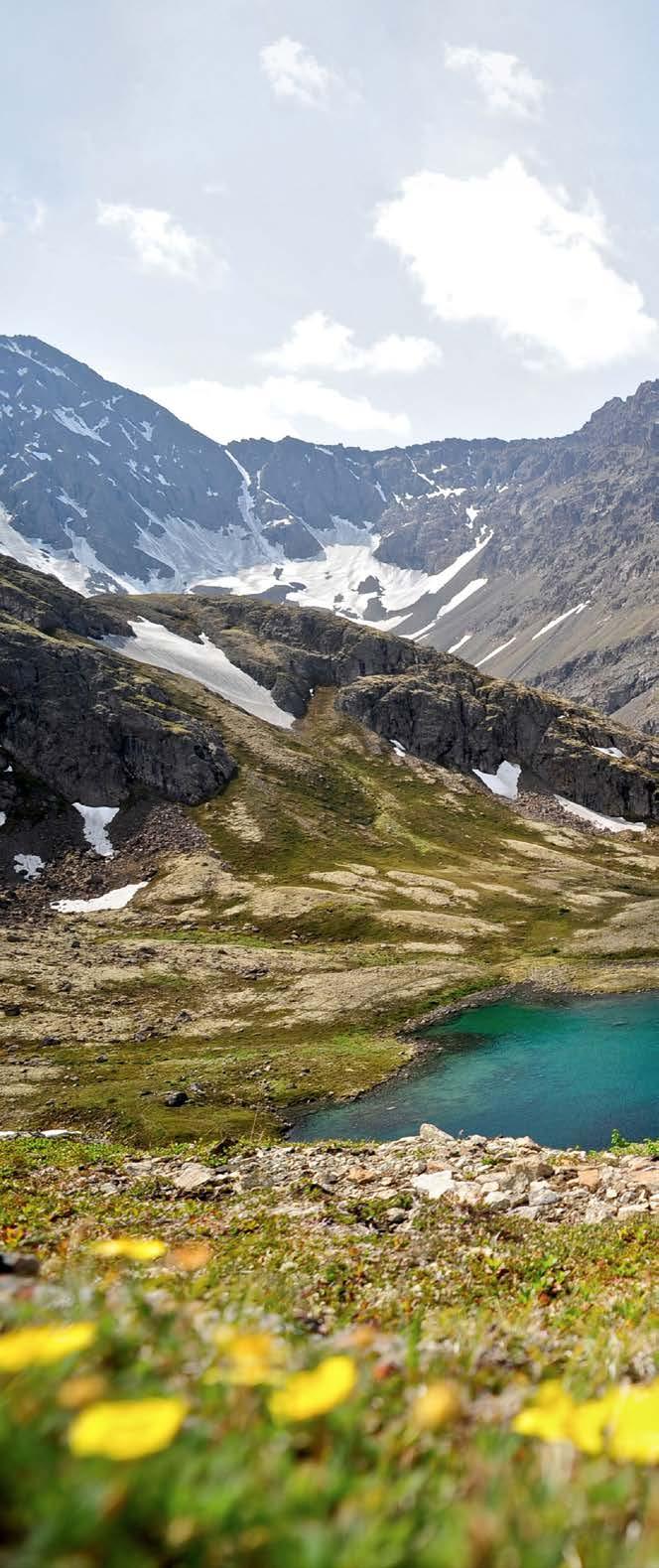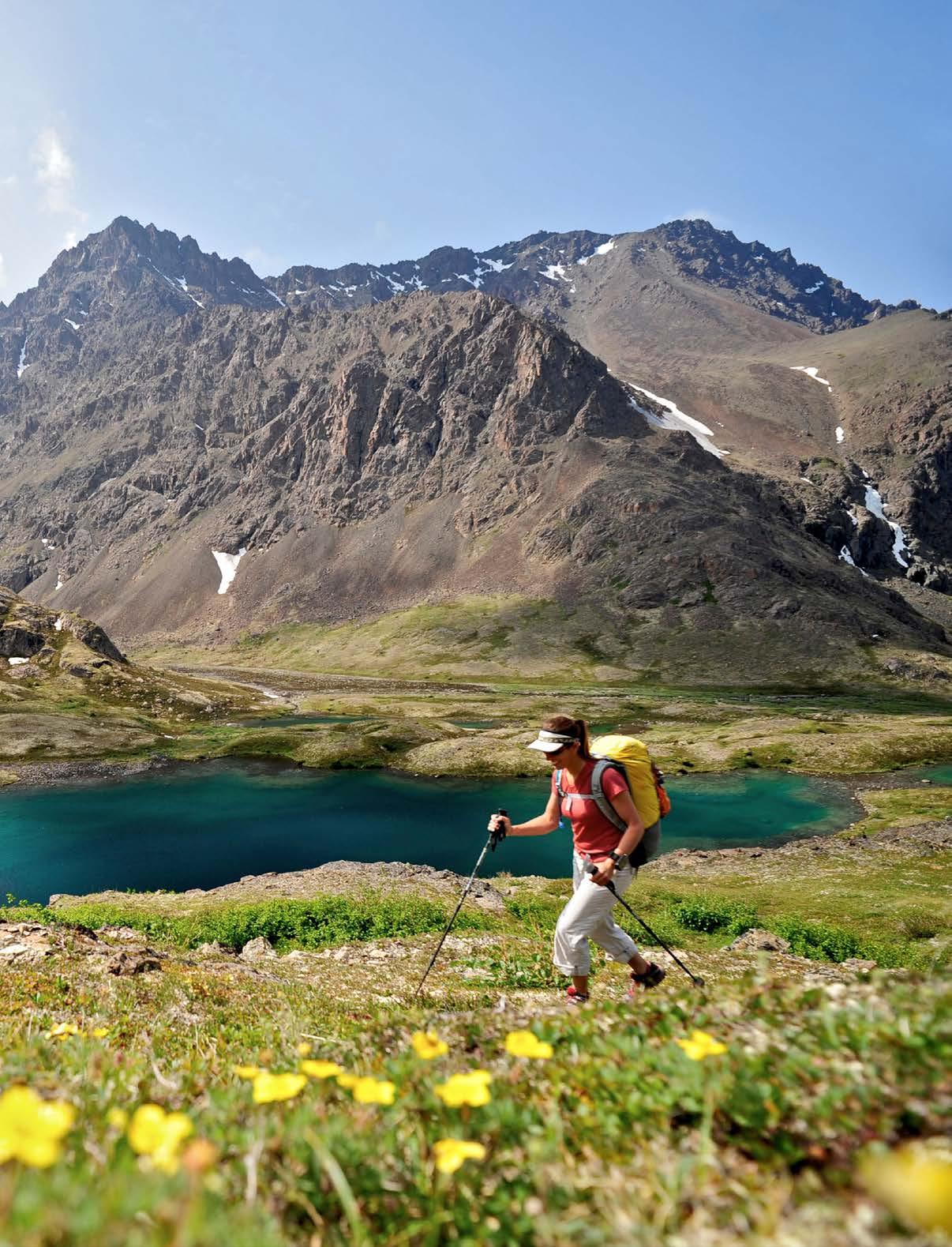How to avoid travel scams
Find a furry friend at a sanctuary
Explore Rogue Valley, Ore.


How to avoid travel scams
Find a furry friend at a sanctuary
Explore Rogue Valley, Ore.

Explore these state parks and public lands instead of crowded national parks.
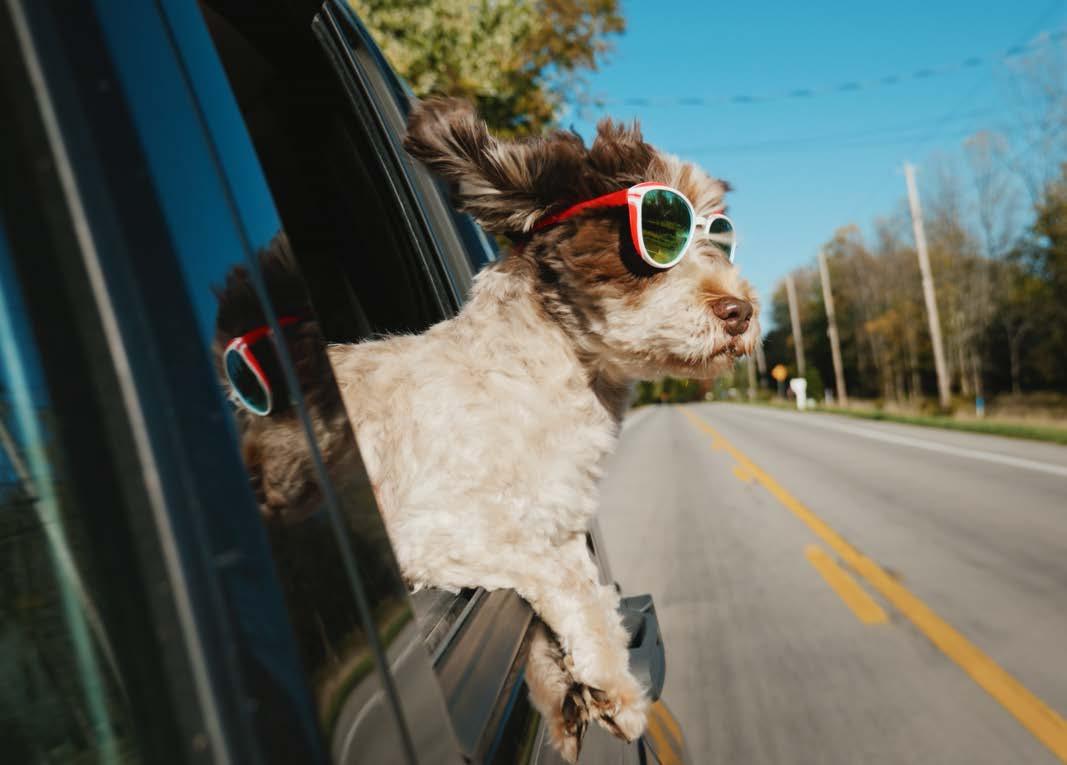






EDITOR Whitney Phaneuf
MANAGING EDITOR Katie Henry
CONTRIBUTING EDITOR Mandy Ferreira
DESIGN DIRECTOR Monica Ewing Jensen
PHOTO EDITOR Maggie Perkins
Digital
SOCIAL MEDIA STRATEGIST Amy Mackey
Advertising
ADVERTISING MANAGER Natasha Alcalá
Change of address Allow four weeks’ advance notice. Contact AAA at (800) 922-8228.
Manuscripts and photos Query first; Via assumes no responsibility for return of unsolicited material.
Reprints from Via Contents copyrighted 2023 AAA Northern California, Nevada & Utah. No part of Via may be reprinted without written permission.
Contact Via Editorial Address all mail to Via, AAA, P.O. Box 24502, Oakland, CA 94623, or viamail@via magazine.com. Your input may be edited and published in print or online.
Contact Via Advertising Address all mail to Via Advertising, AAA, P.O. Box 24502, Oakland, CA 94623. Fax (510) 899-0525.


May+June 2024 / Vol. 146 / No. 2
6 To Our Members
Road trip season is calling. Be sure to have AAA along for the journey.
8 Smart Life
smart home How to keep pests out of your home.
smart travel 8 tips to avoid fraud and scams while traveling.
smart auto How to find a quality auto shop and get the most from your mechanic.
18 On the Road
weekender A weekend in Rogue Valley, Ore.
sweet stops Lose yourself in the Lost Sierra.
happy birthday Much to celebrate in Santa Cruz, Calif.
ON THE COVER Hikers on Lakes Trail near Lookout Lake in the Snowy Range area of Medicine Bow-Routt National Forest, Wyo. Page 44

the porcupine gets a wagon ride at Animal Ark near Reno. Page 32
32 Best Animal Sanctuaries in the West
These ethically run homes for adorable creatures allow visitors to get up close and personal.
keridwen cornelius
by
44 The Wanderer’s Guide to the Best in the West
National parks may be America’s greatest idea, but they’re also crowded. Check out these hikes in state parks and other public nature areas instead.
by tim neville
It’s finally our Members’ favorite road trip season—summer. There are so many incredible national parks in the West I want to get to, but our feature story in this issue of Via has me also considering some less frequented state parks and national monuments. With reservations required at many of the most popular parks in the West, including Yosemite and Zion, it’s great to have more options for an impromptu weekend trip.
As you hit the road, know that our reliable roadside assistance services will be there for you, wherever you go. Whether it’s a flat tire or a dead battery, unlocking your car or delivering emergency fuel, these services are right at your fingertips with a phone call or through our AAA Mobile App. One easy press of the “Request Roadside” button and you are digitally connected—no phone call required—using your smartphone to accelerate your request.
Here’s something we also think is handy: Your roadside coverage (just like your Member benefits) travel with you, not just your vehicle. So, whether it’s in your car, a friend’s vehicle, or even a rental car, you get the same roadside protection—as the driver or as a passenger.

Before you embark on your summer vacation, it’s good to take stock of how you’re keeping your home secure. I regularly check in on my house while I’m away using the cameras and app provided by our very own AAA Smart Home Security. It’s affordable and easy to use, plus Members save up to $60 per year.
I have one more thing I’d love you to keep in mind while you’re out and about—stay alert for first responders and emergency service personnel on the side of the road, including our yellow tow trucks assisting Members. When you see the emergency lights of these vehicles, please do two things: Slow down, and if it’s safe to do so, move over a lane and give them more space.
Enjoy this issue of Via, and don’t miss the magazine’s new podcast, which takes Members on a journey every two weeks to discover the fascinating places, people, and stories that make the West so special. As always, thanks for allowing us to serve you.

CLAY CREASEY, PRESIDENT & CEO (INTERIM)
Share your thoughts
Send comments, tips, or questions to viamail@ viamagazine.com or Via, AAA, P.O. Box 24502, Oakland, CA 94623. Your input may be edited and published in print or online.



↘ Prevent mice, ants, bedbugs, and more.
All sorts of critters—cockroaches, ants, mosquitoes, rodents, and more— are eager to make their way into your home. But these uninvited house guests can be more than just an irritation. Pests can carry and spread disease and trigger health problems, such as asthma or allergies.
“Pests need three main things: food, shelter, and water,” says Brittany Campbell, a staff entomologist with the National Pest Management Association. Often, homes present abundant options for pests to get their needs met—food can be found in the kitchen and living room, comfortable interiors can be all too welcoming, and water can drip, leak, or collect from fixtures and condensation.
Fortunately, these simple, effective strategies from experts can help make your home less inviting to rodents and insects all year round.

The first tip is the simplest, although it requires regular attention: Clean up after yourself, particularly when it comes to food. Just a few simple steps, such as wiping down the counters after cooking and washing dishes instead of letting them soak overnight in the sink, will make your home less attractive to pests.
Reduce clutter. That includes papers, cardboard boxes, piles of clothing, and so on.

Clean your kitchen nightly. Do the dishes, put away food, and wipe down the counters. You’ll also want to make sure that garbage cans or compost bins in the kitchen are tightly sealed and that recycling is clean before going into the bin.

Be thoughtful with pet food. Kibble and other pet food can easily attract and sustain pests. Store bags of dry pet food in an airtight container, and consider only having food bowls out during mealtime. Don’t leave bowls of food outside overnight.
Deep clean monthly. Crumbs and moisture may lurk behind the fridge and dishwasher. “That provides pests with darkness, water, and food,” says Joshua Foster, executive director at Zap Termite and Pest Control. Take the time to vacuum and clean in these spots, and any areas where you often eat, such as your dining table or couch.

Properly store food. Pantry pests—such as tiny beetles and moths—adore flour, grain, and cereal, notes Campbell. Entry is easy when these foods are in their original packaging. Decant items into airtight containers to prevent pantry pests from gaining access or spreading from one item to its neighbor.

Moisture creates a friendly environment for pests, says Campbell. That includes termites, carpenter ants, mosquitoes, roaches, and many others. Reduce the moisture, and you’ll make your home less inviting.
Eliminate moisture outside. Check gutters to make sure they’re not clogged, and clean them out if they are. Make sure drain spouts are aimed away from your home, and cut down on standing water in your yard (think: the kiddie pool, a bird bath, or plant saucers). “Anything that’s overturned and can collect water, even [if it’s] the size of a bottle cap, can breed mosquitoes,” says Campbell.
Look for moisture within your home. A small leak from the garbage disposal might be hard to spot, but it can be attractive to cockroaches or other pests, Foster points out. Check for leaks, dripping faucets, and other sources of moisture and fix them. If your home shows signs of being moist in general—such as a musty smell or condensation on windows— consider running a dehumidifier.
Run the bathroom fan. Taking a shower leaves behind residual moisture. Turn on the fan before you get in, and leave it on until the water is off and the steam has fully cleared. Make sure any other humid areas, such as the kitchen or laundry room are well ventilated.

Pests don’t need much space to get into your home. A small hole in a window screen is an easy entry point for insects, while mice can squeeze through a hole as small as a nickel, according to the CDC.
Look for holes. Walk around the exterior of your home and look for ways pests could get in. Pay particular attention to the foundation and any spot where plumbing or air vents exit the wall. Follow the same process inside, looking for holes in screens, cracks in the wall, and so on. Check around pipes, under cabinets, around floor and wall vents, and in the attic and basement.

Fill in holes. Once you’ve identified potential entry points, eliminate them. Use caulk to fill in cracks and holes around utilities and pipes, says Campbell. With bigger holes, or if you’re wary of rodents, place steel wool or rubber mesh around the area before caulking it up, she says. For larger holes, you can also use metal sheeting or cement to seal it up.

Examine and replace screens. Over time, holes and tears can develop in screens. Take a look at yours, and repair or replace as necessary. “The goal is to make the environment hard to access,” says Foster—that’ll encourage pests to reside elsewhere.

Install door sweeps and weatherstripping. If you can see light around a door or window, that’s an indicator that you’ve got gaps that could allow a pest through, says Foster. Attach door sweeps, which are available at home improvement stores, to the bottom of the door to fill in the gap between the door and the threshold. Add or replace weatherstripping around windows and doors.

The outdoors is home to many of the same pests that seek entry to your home. When you’re barbecuing or having a drink on your patio, the last thing you want is a parade of rodents and bugs.
“There are plenty of insects—good and bad—outside, so it’s going to be hard to prevent interacting with any pests while you’re outdoors,” says Campbell. Still, there are ways to cut down on ants walking across your plate.
Keep an eye on your landscaping. Mow the lawn regularly and keep plants around the house, and anywhere you like to lounge, trimmed back. Trees and bushes can create a bridge into the house, Campbell says. By maintaining landscaping, you’ll reduce the chances of entry into your home and cut down on insects congregating on your patio.
Use pest-proof outdoor garbage cans. If your cans are easy to open, animals will feast on your scraps. Opt for animal-proof options, and don’t let trash spill or overflow.
Apply repellent. Use an EPA-registered repellent to keep mosquitoes from nibbling on you.
Be smart about food. You can eat and relax outside without providing a tempting meal for bugs. Cover food during meals, and keep a lid on any sugary drinks. “As soon as you’re done eating, don’t let the food sit around,” says Campbell. “Take everything indoors to prevent pests from being attracted to your barbecue area.” Sweep up crumbs and wipe down the table and chairs, too.
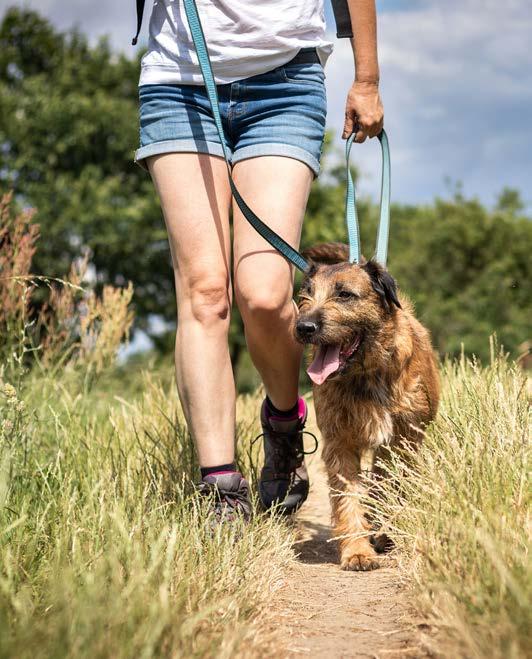
Bedbugs, ticks, and ants can be inadvertently carried into your home. “As a society, we haven’t developed a way to prevent bed bugs from traveling from one place to another and infesting a new place,” says Foster. These hitchhikers travel on luggage and used furniture, according to the Environmental Protection Agency. Sharp observation skills—particularly at spots where people gather, such as hotels and movie theaters—can help you be aware of their presence, says Foster.
Check for signs of bed bugs when traveling. When you arrive at a hotel, place your luggage on the bathroom’s tiled floor. Unlike the carpeted floor or bed, this is a “highly unlikely place for bedbugs to be,” Campbell says. Then, pull back the sheets so you can check the mattress and box spring for signs of bedbugs, which include live bugs (which are about the size of an apple seed), fecal stains, and shed skin, says Campbell. If you find evidence, request another room. Once you return home, examine your luggage for signs of bed bugs before bringing it into your home.

Put an allergen-proof mattress cover on your bed at home. “Mattress wraps are very efficient,” says Foster. They prevent bugs from getting comfortable in the mattress and seal off any existing bugs, he says. If the cover is a light color, it will also help make bed bugs easier to spot. Plus, these fabric covers can prevent dust mites—which can cause allergies—from forming a colony in your bed.
Inspect delivered packages. The EPA recommends checking packages for pests before bringing them inside.

Inspect secondhand furniture and clothing. Before bringing used items into the home, check for signs of bedbugs, termites, and ants, such as the presence of the insects, fecal stains, or holes or damage in the wood. Use high heat to dry secondhand clothing when possible to ensure that you kill any bed bugs.

Inspect yourself—and pets— for ticks after being outside in grassy or woody areas (potentially including your own yard). Check your clothing, backpack, and body for ticks and remove any that you find. Inspect your dog for ticks after walks as well—focus on looking around the ears, eyelids, and tail; between the hind legs; under the front legs and collar; and between the toes, advises the CDC.

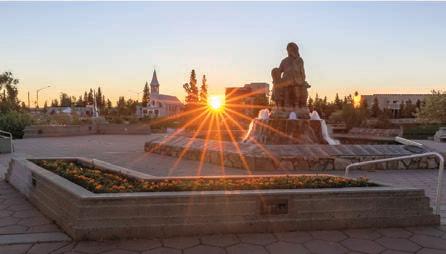
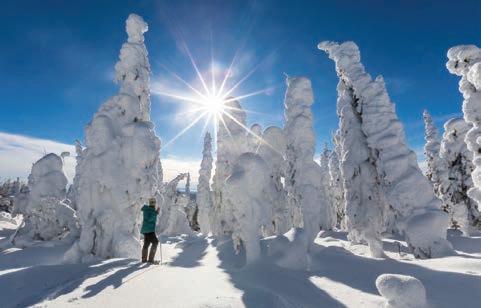








↘ Have your antenna up for these common scammer scenarios.
The internet has made it easy for travelers to book flights and hotels, obtain visas, and secure reservations for hot restaurants and tourist attractions online. Some airlines, such as Frontier, no longer provide customer service by phone, while others charge a fee to book with a live agent.
But the internet has also opened new routes for con artists to steal travelers’ money—and sometimes their identities—especially when someone’s in a hurry, jet lagged, or in a foreign country.
To prevent your dream vacation from turning into a nightmare, here are some common travel scams and ways to avoid them.
The most common travel scams reported to the AARP Fraud Watch Network “started with a mis-search online,” says Amy Nofziger, AARP’s director of fraud victim support. Scammers can create a fake website that looks like a legitimate company and either manipulate search results or pay to have theirs appear at the top.
“We are conditioned to take the first return,” Nofziger says. Many people encounter scammers by searching for terms such as “cheap rental cars.”
To avoid this ruse, enter the company’s name, skip over the sponsored results, and go directly to its website. Then check the URL to make sure it’s actually the right company. For example, Southwest Airlines is at southwest.com, not something like travelsouthwest.com.
Say you’re at the airport dealing with a canceled flight. You’re tired, you’re stressed, and so rather than wait in a huge line, you decide to call the airline to rebook.
You go online to find the phone number—some legit companies deliberately make them hard to find—and end up with a fake customer service agent who wants your credit card information or an alternative payment form. Or maybe you reach the real airline, but the wait time is approximately one hour, so you search for a “backdoor number,” and bam, it’s a scam!

To verify a phone number, look at the number on your frequent flier card (if you have one) or your flight or hotel confirmation, or plug it into a “reverse phone number lookup” site.
Don’t be a victim of look-alike websites claiming to help you enroll in the U.S. Transportation Security Administration (TSA) PreCheck or U.S. Customs and Border Protection's Global Entry program. These programs help speed you through security and customs at U.S. airports, but require a lot of personal information that is catnip to identity thieves. To apply for these programs, always go to the U.S. government’s website.
Likewise, if you need a visa to visit a foreign country, get it from the foreign government’s website, not from an offi-

cial-looking third-party website that will (at best) charge unnecessary fees or (at worst) steal your money and your identity. To find visa requirements for specific countries and links to their websites, go to travel.state.gov.
In 2023, some travelers who had made hotel reservations through the well-known website Booking.com reportedly got emails from the hotel saying their payment had not gone through and they needed to click on a link to confirm their payment information within hours or lose their reservation. Unlike other “phishing scams,” the emails were convincing, because they came from a Booking.com email and showed up in their Booking.com mobile app. But they were fraudulent.
Some hotels claimed that Booking.com had been hacked, which the company denied. In an email, Booking. com reminded users that “no legitimate transaction will ever require a customer to provide their credit card details by phone, email, or text message (including WhatsApp).”
Perhaps you’ve received a phone call, email, or postcard saying you’ve won a free or ridiculously cheap vacation or cruise. “Sometimes they mimic well-known companies. A lot of times there is pressure to act in the next 24 hours to accept this vacation,” says Melanie McGovern, spokesperson for the International Association of Better Business Bureaus.
Ask yourself: Did you enter a contest? If not, it’s likely an outright scam or a vacation riddled with hidden fees. If the offer seems to come from a legitimate company, contact that company directly.

Never use an unsecured public Wi-Fi network to conduct financial transactions, McGovern says. Use cellular data or a virtual private network (VPN), or else wait until you can find a secured Wi-Fi network. You can connect a laptop or tablet to your mobile phone’s cellular network by using the “hotspot” feature on your phone.
“Whenever possible, use a credit card. That’s the gold standard in terms of fraud protections and dispute resolution,” says Ted Rossman, a senior industry analyst at Bankrate.com.
If a company asks you to pay with a gift card, prepaid card, or payment app such as PayPal, Venmo, or Zelle, “that could be a red flag,” he added. American Airlines wouldn’t ask for these, but something like a local tour company might. That’s where you could potentially be at risk.
These alternative payment types don’t have the same legal protections for unauthorized or unfulfilled purchases that apply to consumer credit cards. Debit cards—and
some prepaid cards, if you register them—have similar protections, but they’re somewhat less robust.
Zelle even warns on its website that it “does not offer purchase protection. If you don’t know a person or aren’t sure you’ll get what you paid for, using your credit card may be a better payment option.”
If you do see an unauthorized or fraudulent charge, contact the card issuer immediately to protect your rights.
Letting people know you’re away puts your home at risk of a robbery and your family at risk of the “grandparents scam,” Nofziger says. This happens when seniors get a call from someone impersonating a grandchild, saying they’ve been in an accident or arrested in a city where the grandchild actually may be, and they need money fast. “Don’t tell mom or dad,” the scammer may plead, handing the phone to a “lawyer” or “cop” demanding immediate payment.
kathleen pender

↘ 5 easy steps to create a beneficial and positive relationship with your auto mechanic.
We all know that familiar scenario: The engine won’t turn over when leaving for work, the check engine light unexpectedly pops on, or a small squeak starts to become a persistent whine that you can no longer—and shouldn’t have to begin with—ignore. It’s inevitable over the course of car ownership to need to visit an auto shop, but the process can be seamless and easy when you have a trusted one on call. These tips will help you find the right shop and mechanic to ease your inevitable car troubles.
Find the right auto shop.
A reliable repair shop makes all the difference. Search for a dependable one online with the AAA Shop Locator, where you’ll find easy-to-access information on AAA Owned and Operated Auto Repair Centers in the West. Far from home? AAA Approved Auto Repair facilities are located across the country.
Build a relationship with your mechanic.
Once you’ve found a good repair shop, stick with it, even for minor maintenance. A trustworthy technician who knows you and your vehicle is your best source of advice on what needs to get done.
Talk about the future.
If you have one job under way and you’d like to know whether your vehicle needs any preventive work, tell the shop how long you plan to keep the car and what your maintenance budget is. It may be that if you spend a little extra now, you could save a bundle down the line.
Is your car coughing? Wheezing? Whining? Smoking? Describe the problem in as much detail as possible without speculating about the cause. Leave it to your technician to determine the ailment and prescribe the cure.
Get a backup ride.
If your vehicle is out of commission but you still need to get around, an Approved Auto Repair shop can help get you a temporary ride. josh sens AAA Member Savings
Save 10% on labor costs, up to $75, and get a two-year extended warranty at AAA Auto Repair Centers. Learn more.

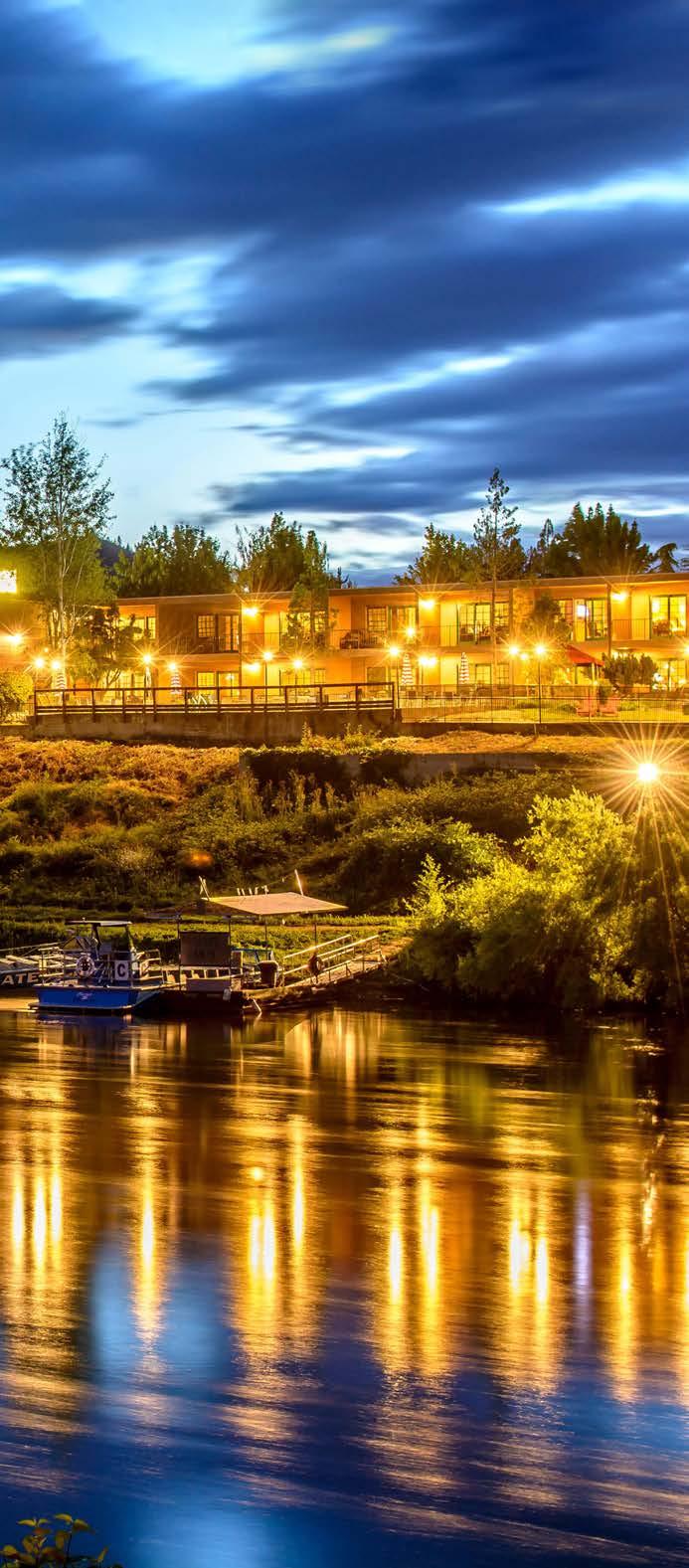
↘ A river runs through this picturesque Gold Rush town.
Just over the California border in southern Oregon, the Rogue Valley makes an ideal getaway for a long weekend, especially in summer, when the days are long and temperatures are balmy. Whether you’re in the mood for hiking, winetasting, or exploring a historic downtown, you’ll find delights here for the entire family.
● From Memorial Day to Labor Day, hunt for bears around the valley’s main hub, Grants Pass—but don’t worry, these bears don’t bite. Instead, whimsical fiberglass statues can be found all around town, each involved in its own distinct activity, from pushing off on a skateboard or pedaling a trike to delivering mail. Find a bear map online at Evergreen Federal Bank: The local lender kicked off the public art project in 2003, and the hunt has since grown into an annual tradition.
● Get a lesson in all things cheese at Rogue Creamery Dairy and Farm Stand, creator of Rogue River Blue, which was named the World’s Best Blue Cheese by the World Cheese Awards at the 2019/2020 international cheese competition. Take a free guided tour to see Holstein, Brown Swiss, and Jersey cows being milked by robotic milking
machines, some of the first implemented in Oregon. Afterward, savor a grilled cheese sandwich in the leafy picnic area.
● For more cheese fun, visit Wooldridge Creek, Oregon’s first combo winery and creamery, established in 2015. The boutique spot specializes in both small-production artisan cheeses and estate wines, particularly hefty reds such as Tempranillo and Malbec. Enjoy a wine flight on the patio alongside a cheese plate complete with house-made pickles.
● With a blooming flower garden, abundant koi pond, and rows of vines, Dancin Vineyard, 35 minutes south on I-5 in Medford, boasts a setting so beautiful you’ll be hard pressed to leave. The wines are named for ballet movements, a nod to the philosophy that winemaking is akin to a dance with nature. It doesn’t get better than a pork belly and brie pizza fresh out of the oven, paired with a glass of En Bas Pinot Noir.
● Twelve minutes west of Medford, explore Jacksonville, a town designated a National Historic Landmark. One of the best ways to see this 1800s gold-boom town is to jump on a narrated trolley tour that rumbles past the state’s oldest city hall (circa 1880) as well as majestic Victorian homes. From June to September, visitors come from all over for the Britt Festival, a music celebration named after famed photographer and horticulturalist Peter Britt, one of Jacksonville’s most important settlers.
● Stretch your legs in Jacksonville on the Enchanted Forest Trail, a 1.7-mile moderategrade path with throngs of butterflies in summer. For a less strenuous outing with a rare find, head to the Eight Dollar Mountain Botanical Wayside, 26 miles southwest of Grants Pass. This 1/8-mile wheelchair-accessible boardwalk meanders over a botanical wetland preserve filled with yellowish-green cobra lilies, the only member of the carnivorous pitcher plant family found in Oregon.
● Or go off the beaten path to Nymph and Woodsman, a 280-acre farm in Jacksonville that offers a unique, reserve-ahead group experience: a plant walk on the grounds, complete with BYO picnic lunch and lessons in making your own herbal tincture to take home.
● In Grants Pass, refuel on the expansive deck overlooking the Rogue River at Taprock Northwest Grill—a grand structure in timber and stone resembling a fishing lodge—with halibut tacos drizzled with cilantro lime crema or a Wagyu patty melt served with a mountain of thick onion rings. Or enjoy a soulful taste of Cuban food at Cultured Palate in downtown. Owner Angela Padilla even brings out sample tastes of her slowcooked pork, chicken, and beef to entice newcomers before they order. Don’t miss the house-made flan, a thick wedge drenched in burnt caramel.
● There’s something for everyone at Bohemian Bar & Bistro, another downtown Grants Pass establishment, which serves up creative seasonal cocktails along with lamb gyros and some of the best dry-rub chicken wings around.
● If you’re headed to or from Oregon Caves National Monument, a must-stop is Taylor’s Sausage Country Store, a family-owned institution in Cave Junction since 1924. It doubled in size in early 2024 to add more seating and a larger kitchen, where cooks craft nearly 100 different kinds of sausage. Take a seat on the patio to savor a paprikalaced Hungarian sausage on a bun with a side of creamy, sweet baked beans.
● Only two miles off I-5 in downtown Grants Pass, The Lodge at Riverside is as convenient as it gets. In addition to its spacious rooms, many of them overlooking the Rogue River, this charming establishment with rustic touches offers complimentary breakfast,



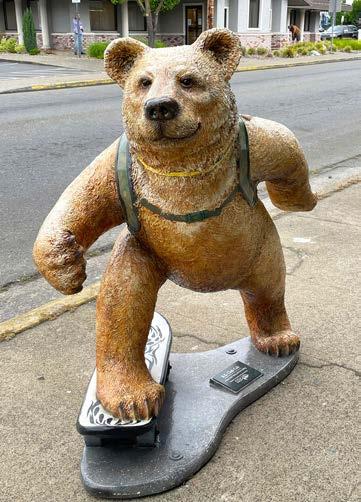

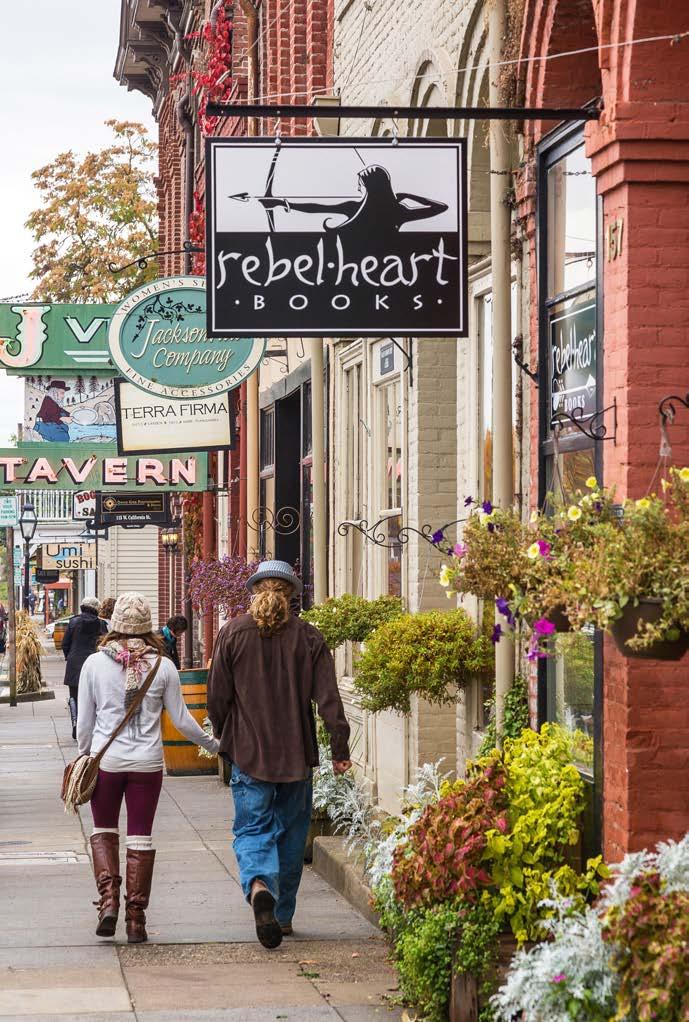


afternoon wine and cheese, and afterdinner cookies with milk.
● Guests enjoy similar complimentary treats at the circa-1924 Weasku Inn along the banks of the Rogue River in Grants Pass. Once a vacation retreat for old-Hollywood luminaries such as Clark Gable, Carol Lombard, and Walt Disney, this historic property now boasts a five-room main lodge as well as cabins featuring gas fireplaces framed by river rock.
● Find items for your modern wardrobe and specialty vintage clothing— think ultra rare pieces dating back to the 1920s—at Woven and Wyld in downtown Grants Pass. Co-owner Ashleigh Bracy can even help you cre-
ate a capsule wardrobe with beautiful pieces to compliment every style. The boutique carries something for everyone, from your 10 year old daughter to your 80 year old grandmother. Super Natural Chocolates, a bean-to-bar factory, specializes in raw chocolate, which in the wrong hands can sometimes be off-putting for its gritty texture. That’s why owner Savannah Cobain takes the tack of grinding Peruvian and Ecuadoran cacao bean nibs for five days, ensuring incomparable smoothness while maintaining antioxidants. Her handmade truffles, available in 12 flavors, have won fans nationwide. Pick up a gluten-free, dairy-free cupcake, too, that’s remarkably indulgent.
● A bucolic paradise awaits at Pennington Farms, a 90-acre family-
owned farm and bakery in the heart of the Applegate Valley in Grants Pass. Jars of homemade tayberry and marionberry jams tempt, along with peach-blueberry scones, chicken pot pies, and ginormous cinnamon rolls. Thanks to co-owner Sam Pennington, who’s from Hawaii, Kona coffee beans are also stocked.
● Step back in time at the Grants Pass Pharmacy. Yes, you can get prescriptions filled, as well as shop for greeting cards and old-fashioned candies galore. But the real draw is the historic soda fountain that’s been in operation since 1933. Have one of the teenage soda jerks make you a phosphate, a from-scratch soda that gets its name from the addition of phosphoric acid to lend a distinctive tartness.
carolyn jung

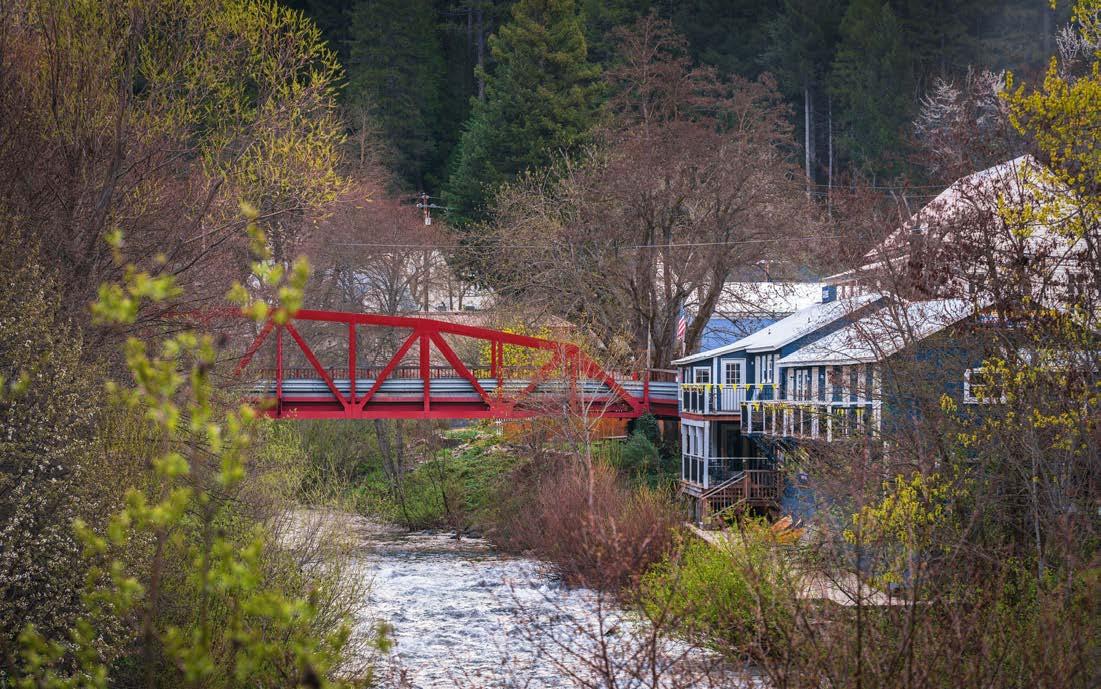
↘ Tumbling rivers, azure lakes, hot springs, and historic gold mining towns are just some of the riches in this unspoiled wonderland.
photography by kial james
Follow the winding ribbon of the Yuba River up the northernmost stretch of Highway 49, passing one tempting swimming hole after another, and you’ll feel like you’ve stumbled on a secret corner of the Sierras that time forgot. With uncrowded trails, serene and motor-free lakes, wild rivers, and towns little changed over the past 150 years, the Lost Sierra, as it is now known, makes the perfect setting for an old-time mountain road trip.
A tiny hamlet of 200 people, this former Gold Rush boomtown still retains the photogenic balconied storefronts and wooden sidewalks of its heyday. Downieville owes its rebirth as an out-
door adventure hub to the mountain bikers who come for the dizzying 15-mile plunge popularized by the Downieville Classic Downhill race. But just as many come to hike, fish, kayak, or simply swim and lounge along the two rivers that run directly through town. Downieville Outfitters will rent you mountain bikes, or e-bikes for those less ambitious. Thanks to a cluster of friendly, historic, and well-outfitted hotels—the Carriage House Inn, Riverside Mountain Lodge, and Downieville River Inn & Resort—the town makes an excellent home base for exploring the region.
Start your day at Sabrina’s at the Forks, which opens early to serve hearty fare from scrambles to
salmon-topped bowls. Cool down after your hike with an ice cream or iced coffee at Cold Rush Café, which also offers breakfast and lunch in partnership with adjoining Empire Creek Provisions, where you’ll find the makings of a gourmet picnic, from artisanal cheeses and breads to sweets and savory snacks. The big news in town is the opening of JADAA’s Kitchen, a long-awaited permanent location for a beloved seasonal food truck. La Cocina del Oro opens this summer with creative veggie-forward Mexican fare and a festive river deck.
Evenings find locals and visitors alike gathering at St. Charles Place, a timetested Western saloon where dogs snooze under the century-old mirror-backed bar and a friendly pool game is perpetually in progress. Speaking of dogs, Downieville welcomes them so enthusiastically that at times they seem to outnumber people.
With the Pacific Crest Trail crossing Highway 49 just a mile past town, Sierra City buzzes from spring through fall with the activity of through-hikers who congregate on the porch of the Sierra Country Store. It’s not often that you get to hear— and feel—the vibrating clang of an original Gold Rush stamp mill, but that’s one highlight of the twice-daily tours at the Kentucky Mine Historic Park and Museum, which also hosts the Music at the Mines concert series on select summer weekends.
Daydream an instant and you’ll miss twoblock Sierraville, but it’s worth a stop for the fluffy biscuits and breakfast burritos at Smithneck Farm’s Cafe, or the smokeinfused BBQ at the Farmhouse Café next door. On Mondays, the valley turns out for the café’s weekly multicourse dinner featuring homey fare such as lasagna and pot pie. Perhaps Sierraville’s biggest




draw, clothing-optional Sierra Hot Springs, offers day and evening passes to its multiple soaking pools as well as on-site camping and rustic lodging.
This trio of towns at the northern end of the Sierra Valley boasts the area’s biggest selection of restaurants, stores, and facilities, including 18-hole Graeagle Golf Course. Stay at the retro-chic Clio Inn, where the woodsy, pine-paneled rooms reflect the building’s history as the former general store and the downstairs taproom continues the tavern tradition. Stop into the Lost Sierra Visitor Center in
Blairsden, or pick up an official Lost Sierra trail map from the outdoor supply shop and head up the Gold Lakes Highway to start your lake adventure.
To complete your loop, take the Gold Lake Highway through the Lakes Basin Recreation Area, passing a string of stunning alpine lakes framed by the granite peaks of Mt. Elwell and the Sierra Buttes. The glacier-carved basin encloses some 50-plus lakes, among them boater-friendly Gold Lake and Salmon Lake, a favorite for swimming. The basin’s network of hiking trails are connected to a key portion of the Lost Sierra Route, an ambitious 600-mile complex of multi-use hiking, biking,
and equestrian trails under construction by the Sierra Buttes Trail Stewardship that will ultimately connect 15 mountain communities.
For a good introduction to the region, choose the 1.3-mile Sardine Lakes trail and the paved mile-long path to multitiered Frazier Falls. Those up for something more strenuous might opt for the five-mile climb to the Sierra Buttes Fire Lookout, with its unparalleled 360-degree views, or the six-mile trek to Jamison Lake, ringed with sun-splashed boulders perfect for picnicking.
With so many choices, it’s no wonder that both adventurers and nature lovers are lured back time and time again to explore the Lost Sierra.



↘ The Giant Dipper’s 100th birthday is just one reason to visit the bustling seaside town.

Despite its laid-back, unassuming image, Santa Cruz is home to a few major historic landmarks. Set along Monterey Bay, the town is the birthplace of mainland surfing, introduced in 1885 by three visiting Hawaiian princes who showed locals how to catch waves using redwood planks. This history is commemorated along West Cliff Drive at the Surfing Museum, with its iconic bronze statue of a surfer. The locale is also a great spot to see locals catching epic waves from the cliffs above. Another thrilling landmark? The Giant Dipper, the crown jewel of the Santa Cruz Beach Boardwalk, California’s oldest continuously operating theme park. In 1987, the wooden roller coaster was offi-
cially designated a National Historic Landmark. This year, the beloved coaster turns 100, and fans can join the celebration with $1 rides every Wednesday and free commemorative souvenirs on select days. But a visit needn’t be limited to history and heritage. In recent years, Santa Cruz has witnessed a revitalized dining and arts scene that lends visitors plenty of contemporary diversions, too.
The Santa Cruz Beach Boardwalk has filled Main Beach’s sandy shores with squeals of delight since 1907. Today, the seaside amusement park still bustles with classic midway games, spin-
dles of wispy cotton candy, and twirling rides such as the grand Looff Carousel. The park offers state-ofthe-art thrills, too, but its most popular ride dates back to Calvin Coolidge’s time in the White House. Since its opening on May 17, 1924, the Giant Dipper has delighted more than 68 million riders with its 65-foot plunge, soaring ascents, and speeds up to 55 miles per hour. Envisioned by builder Alfred Looff as an all-in-one “earthquake, balloon ascension, and aeroplane drop,” the coaster was a notable departure from the attractions that preceded it, including the Looff carousel, which was hand carved by Alfred’s father, Charles Looff. The scream-inducing ride, later dubbed a “tooth-loosener” and an “eye-popper” by San Francisco Chronicle columnist Herb Caen, was an instant hit at 15 cents a ride. Yet, the coaster nearly met its demise when the younger Looff made plans to disassemble it after failing to quickly recoup the $50,000 building expenses during the Great Depression. (It cur-

rently costs $500,000 just to paint the coaster.) Thankfully, the Boardwalk intervened and has kept the coaster running for generations to enjoy, its 50" minimum height requirement serving as an aspirational milestone for local youth.
This summer, to celebrate the coaster’s centennial year, guests can take a spin on the Dipper for just a buck, every Wednesday from May 29 through August 7, 2024. (The regular ticket price is $8.) Plus, Saturday, August 17, is National Roller Coaster Day, and the first 100 riders will score a free souvenir cup.


The Giant Dipper isn’t the only buzzworthy attraction in 2024. This summer, the Boardwalk will debut two new rides: One of them, the 65-foot Dream Wheel, offers a leisurely spin with sweeping views for four to six passengers aboard colorful, oversize gondolas; for an extra shot of adrenaline, choose Surge, which whirls thrillseekers 360 degrees on a tilting circular platform. In addition, a few lesser-known attractions have undergone a refresh, including Ghost Blasters, a black light–illuminated experience where riders zap cartoonish spooks from a moving cart.
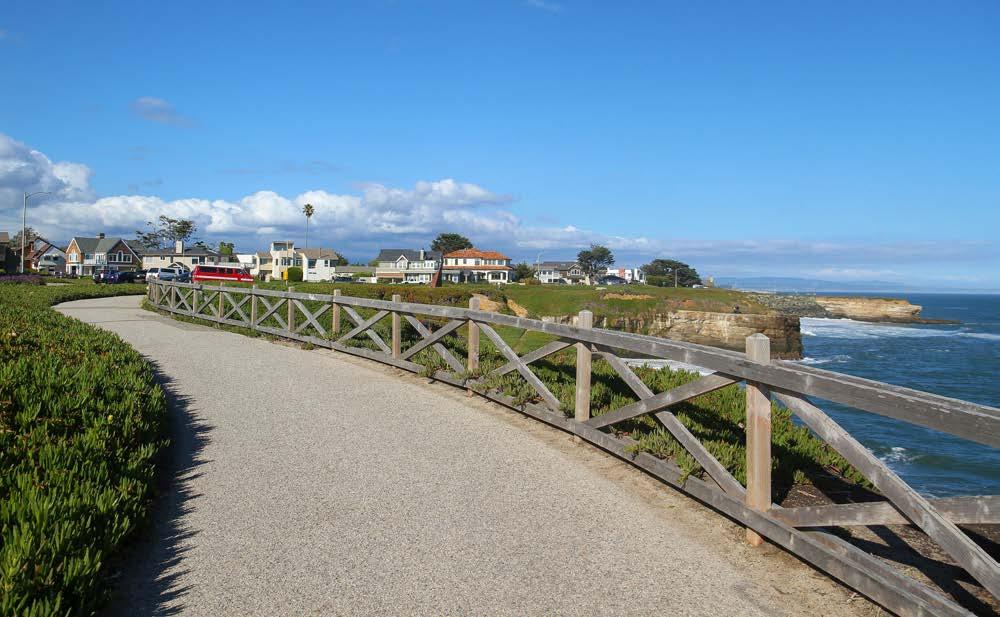

Visitors can discover other sources of local pride besides the Dipper. In addition to an enviable landscape of coastal redwood groves and the city’s Monterey Bay shorefront, a burgeoning movement of artists and chefs is helping to redefine local culture and cuisine while staying true to Santa Cruz’s spirit.
From the Boardwalk, stroll west along West Cliff Drive, an especially scenic promenade that meanders along Monterey Bay with stirring coastal vistas. The path eventually leads to Steamer Lane Supply, a take-away café set within Lighthouse Field State Park and across the street from the eatery’s namesake surf break. At outdoor picnic tables scattered amidst Monterey cypress trees, a convivial mix of visitors and locals, many with surfboards in tow, mingles over fresh fish tacos,
grass-fed smashburgers, and watermelon-lemon-basil aguas frescas.
Situated three blocks from the mistsprayed bluffs overlooking Monterey Bay, Venus Spirits Cocktails & Kitchen Westside is the delicious outgrowth of Sean Venus’s award-winning distillery, which produces small-batch spirits incorporating botanicals plucked from the Santa Cruz Mountains. The sleek and airy restaurant pairs Venus cocktails with refined comfort fare such as a grilled sausage board with dilly beans and pimento cheese.
Home/Work is a fetching boutique with locally designed home goods, art, and apparel such as Megan Sofia’s two-tone pottery and Mike Bencze’s illustrated prints of Santa Cruz landmarks including West Cliff and Henry Cowell Redwoods State Park. The shop also designs its own line of hoodies and caps under the Mountain Sea Living label. garrick ramirez
Through interviews with experts and locals from the American West, the Via Podcast will take you on a new adventure every two weeks. The podcast will also feature stories and recommendations from AAA Members.






A Northern saw-whet owl. This bird was handled for the purpose of scientific research under a federally authorized Bird Banding Permit issued by the USGS and in accordance with all state permitting requirements.


These ethically run homes for adorable creatures allow visitors to get up close and personal.
by keridwen cornelius
Something awakens inside people when we encounter animals up close: the electric thrill of gazing into the wild eyes of a wolf or raptor, the surge of affection when we hug an alpaca or a cow, the playful spirit we feel on seeing a goat or reindeer romp. These connections resonate with an untamed, natural, wiser part of ourselves.
But there’s a caveat. Some tourism experiences force animals into uncomfortable, stressful, and even abusive situations. And it can be difficult for conscientious travelers to determine what goes on behind the scenes at some businesses, or what standards govern their practices.
So we’ve sought out eight opportunities to ethically meet animals up close. “Ethical” means the animals’ welfare comes first—over customers’ desires and the organization’s financial and promotional concerns. The animals live in humane conditions and are treated with love and care. Any interactions between humans and the animals are guided by sensitivity, empathy, and the principle that it’s a delight and honor to be in the presence of these furry, feathered, spiny, or scaly beings.

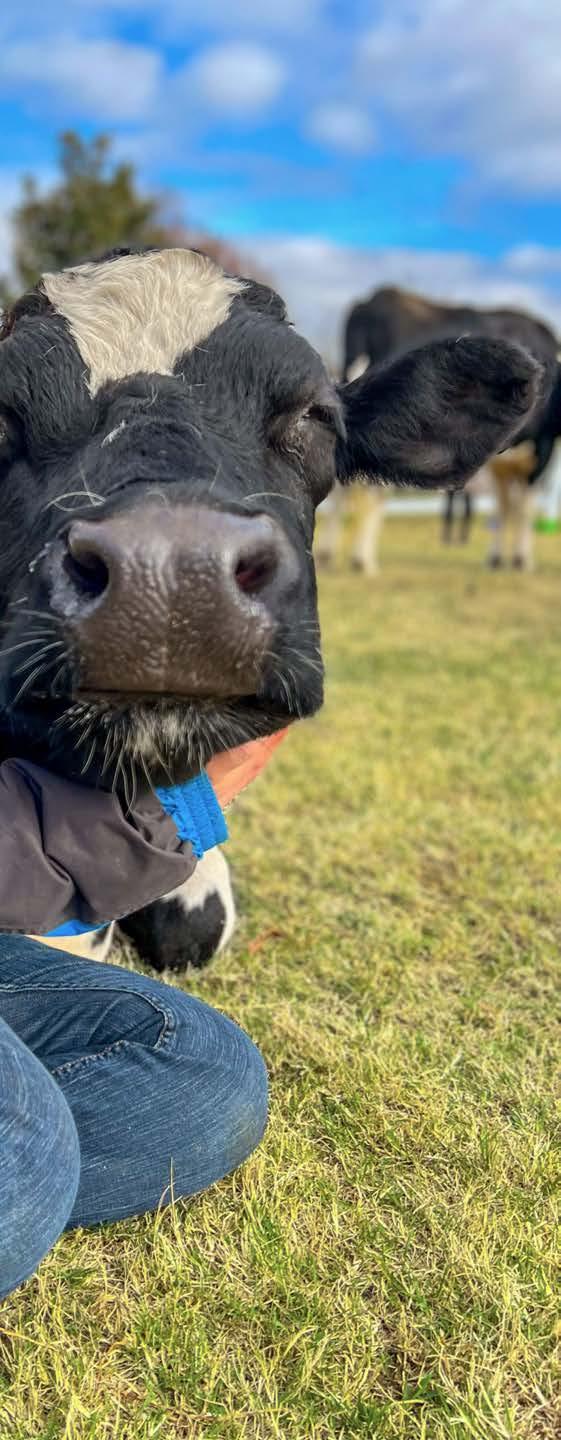
When Ellie Laks visited a California petting zoo in 1999, she became “very aware of how using animals for profit can go extremely wrong,” she says. The ponies were forced to trudge in endless circles with no breaks and no water. Children chased the goats and sheep, who had difficulty walking because their toenails were untrimmed. So Laks took some of the sick and dying animals back to her property, and the Gentle Barn was born.
Now, this Santa Clarita sanctuary hosts therapy sessions for adults and children featuring barnyard animals and even “cow hugs.” In these sessions, animals who have been rescued and rehabilitated from abusive situations can help “heal people with the same stories of trauma,” Laks says. Every Sunday, the Gentle Barn opens for public tours, when visitors can cuddle with cows, pet goats, rub pigs’ bellies, and more. Every animal has a volunteer docent who informs visitors how to interact with them based on the animal’s likes and dislikes.
The sanctuary also hosts Gentle Thanksgiving, when visitors can hug turkeys and feed the birds their favorite treats, from corn to blueberry pie. “[We can] connect with animals in a way that is not causing suffering, but is causing more awareness,” Laks says, “so we can all take better care of Mother Earth and her animals.”
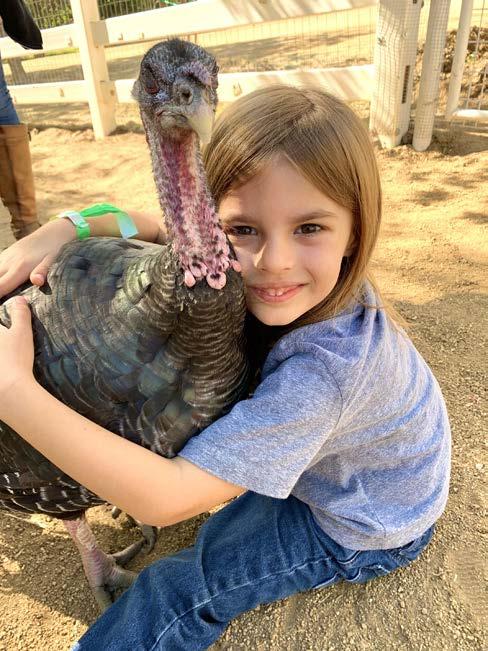

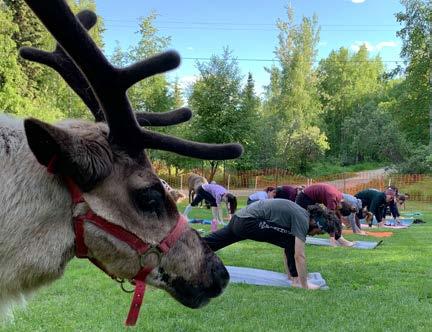
To adapt to the Arctic, reindeer have evolved superpowers. Their eyes change from gold to blue in winter to let in more light. Their ultraviolet vision makes spotting lichen in semidarkness a snap. And their foot ligaments click to help the herd stay together during whiteouts and fog. You too can learn to harmonize with the Alaskan environment on a walk with these remarkable ruminants at Running Reindeer Ranch in Fairbanks.
As the reindeer frolic and forage, life-long Alaskan Jane Atkinson regales participants with the history
of human-reindeer relationships, the biology of reindeer and caribou, and the ecology of this birch boreal forest. “Sometimes the reindeer want to be close to people and lean in for a snuggle,” Atkinson says. “Other times, they’re doing their own thing, and we don’t force them to behave any differently than they feel like.”
The reindeer even act natural during the ranch’s summertime outdoor concerts and yoga sessions. They might graze, curiously sniff people’s belongings, and occasionally nap on the yoga mats. “Reindeer are very sensitive to energy,” Atkinson notes. So they get animated when musicians jam on steel drums or when yogis get into a vinyasa flow. “But by savasana,” Atkinson says, referring to the corpse pose, “they’re all lying down.”
Koda, a brown wolf dog, grew up at an Alaskan roadside attraction where he was chained to a pole, unable to take shelter or escape the loud cars and tourists who paid to take selfies with him. Pack mates Annie, Bella, and Charlie were rescued from a fur farm in Illinois that was shut down for animal cruelty. Now these wolf-dog mixes run free at Wolf Connection, a sanctuary sprawled across 165 acres of the Angeles National Forest north of Los Angeles.
Though many people are captivated by the idea of owning a dog that is partly or mostly wolf, these canines typically do not make good pets. They’re escape artists,
they can be skittish around people, and they get destructive when left alone at home. As a result, the majority of wolf dogs are euthanized or surrendered to sanctuaries. But when cared for by experts and bonded to a pack, they can be wonderful healers.
Wolf Connection provides animal therapy to youth, veterans, women, and others who, like these rescue animals, have a history of trauma and abuse. Through the wisdom of wolves, participants learn to trust their intuition, embrace their wildness, collaborate with a “pack” of people, and connect with nature. Once a month or so, the public can meet the 40-plus wolf dogs at a Run with the Pack event. You’ll meet the pack, go for a short walk with wolf dogs, hear their backstories, and maybe get wolf-dog kisses.
Willow the wolf greeting a young animal therapy participant at Wolf Connection, a 165acre sanctuary north of Los Angeles.


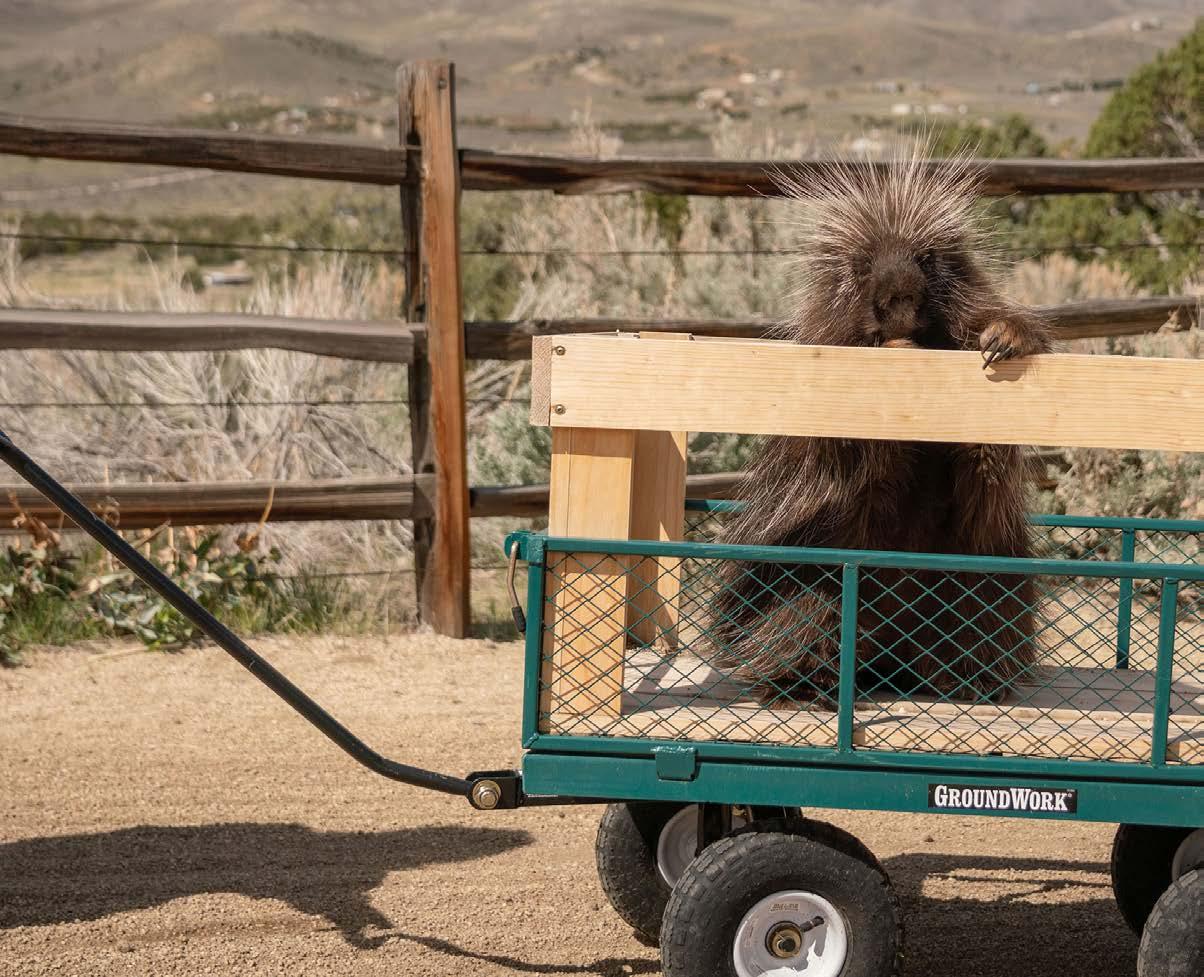
Quillber the porcupine is “a bit of a Picasso,” says Leesa Greenawalt, an animal keeper at Animal Ark near Reno. You can watch the adorable rodent grab a paintbrush and create an abstract, surrealist work of art that you can take home. Alternatively, you can help set up Quillber’s yard, put out his food, and learn how his keepers care for him. These encounters are part of Animal Ark’s new Meet and Greets—private, mostly non-touch sessions when you can learn about the sanctuary’s residents up close. Other options include marveling

at cheetahs training to sprint, petting an iguana or desert tortoise, and seeing Katniss the kestrel (a type of falcon) take a flying lesson with her keeper. Animals come to this Zoological Association of America–accredited facility if they can’t be released into the wild. Some have been injured. Others, like Katniss, were taken by people from their natural homes before they could learn survival skills and were then abandoned or surrendered to the sanctuary. Animal Ark selects only well-socialized animals to engage in Meet and Greets, and they never force them to participate. “It’s always the animal’s choice,” Greenawalt emphasizes. “We want our animals to be as comfortable and happy as possible, because this is their forever home.”

Across the country, potbellied pigs have been abandoned, surrendered, or harmed for reasons ranging from cruelty to myths about how large these pigs will grow. As piglets, brothers Bert and Ernie were dumped in a vacant lot. Creampuff was picked up by the police after they arrested her owner for animal abuse. Maggie and Tomahawk were strays who’d been attacked by dogs. Now they’ve found a safe haven at Ironwood Pig Sanctuary, which has rescued around 1,700 pigs since its founding in 2000. Most will spend the rest of their lives at this refuge in the town of Marana, communing with their porcine companions in open fields, spacious shaded enclosures, and cooling mud wallows.
Every Saturday from October to April, visitors can take a tour (advance registration is required) to meet some of the 680 or so pigs, pet them, and rub their potbellies. Cofounder Mary Schanz considers the pigs her family and ensures their comfort comes first. “We make sure people are not trying to pet or engage a pig that does not welcome their advances,” she says. But pigs are gregarious herd animals, “so many enjoy the attention,” Schanz adds. The facility— which is accredited by the American Sanctuary Association and has a top rating (four stars) from Charity Navigator—also hosts occasional events such as Painting with Pigs, when you can paint porcine portraits and pet pigs as they scuttle past.



Much like potbellied pigs, llamas were once a trendy animal to own, and breeders sold them for huge sums in the 1980s through the early 2000s. After the market burst around 2008, hundreds of these gentle camelids were abandoned, neglected, or surrendered to sanctuaries. Susi Hülsmeyer-Sinay, founder of Yellowstone Llamas, has participated in multiple llama rescues, including capturing abandoned llamas near her Montana property and helping save around 500 llamas from a so-called sanctuary where animals were neglected.
Travelers can befriend Hülsmeyer-Sinay’s llamas on a fivehour trek—with a stop for a picnic—through the forests and meadows of northern Yellowstone National Park.
Alternatively, you can take a 2.5-hour hike with the herd at Sage Lodge in Paradise Valley, north of the park, or visit these woolly-haired charmers at their home on the farm. “The llama trips are enjoyable because you really develop a relationship with your animal,” Hülsmeyer-Sinay says. “Llamas are very in tune with humans and their surroundings, and they often see wildlife before we do. That puts you more in the moment, and it’s very peaceful and healing.”
In northern Utah, tiny forest owls emerge each night from their nests in aspen tree cavities to silently swoop through the darkness in search of mice, moths, and more. Sadly, scientists predict that aspens will nearly disappear from some parts of the West by 2090. This habitat loss threatens the owl species— flammulated, Northern saw-whet, and others—that call aspens home. Conservationists aren’t sure how best to protect these hand-size, yellow-eyed fluffballs. So HawkWatch International and Earthwatch have created an eight-day citizen science expedition near Snowbasin. This opportunity allows members of the public to directly support scientific
research, both with their time and a charitable donation make to the project via their expedition fee. Working alongside biologists, participants will record the locations of aspen tree cavities, document the presence of different owl species based on their toot and boop sounds, and help researchers catch, weigh, and band owls.
HawkWatch International, a research and conservation organization based in Salt Lake City, also offers brief encounters with birds of prey. During Birds in the Lab events at the Natural History Museum of Utah or Reading with Raptors sessions at the Discovery Gateway Children’s Museum, you might stare into the heart-shaped face of a barn owl or enjoy story time alongside a Swainson’s hawk while learning about protecting these magnificent creatures.

under a special use permit from the USFWS for the purpose of science education.
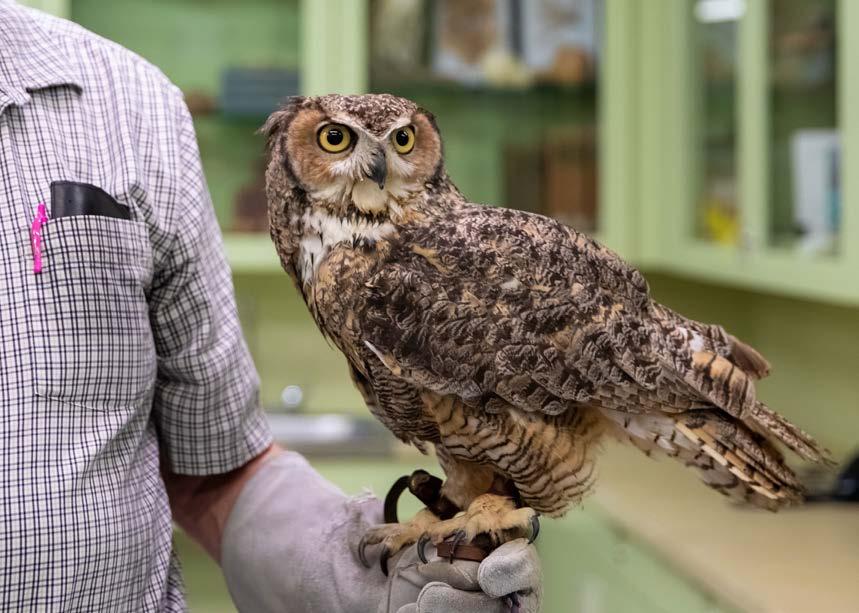


It’s hard to say who’s having a better time during Arizona Goat Yoga’s events: the goats or the people. Goats sporting colorful headdresses or shimmery unicorn horns gambol amid giggling participants as they do downward dog, or clamber on people’s backs during cow pose. Located on a farm in Gilbert, the events usually have themes—1980s, ugly Christmas sweater, Dolly Parton—and sometimes also feature cow cuddling and alpaca nuzzling.
Cavorting to country music is clearly not natural goat behavior. But according to Alan McElligott, an associate professor of animal behavior and welfare who specializes in goats, many goats do enjoy goat yoga. That’s partly
because goats love climbing. Also, goats were domesticated earlier than any animal except dogs, closely interacting with humans for around 11,000 years. Scientists have found that goats can correctly interpret humans’ vocal tones, and they’re drawn to smiling people— which is basically everyone doing goat yoga.
Co-owners April Gould and Sarah Williams consider their goats “beloved pets” and socialize them to be comfortable around humans from a young age. “Our goats enjoy the affection they get from everyone,” says Gould, who’s been raising goats for 20 years. “The fact that my goats actually come up to you and want to be petted says a lot.” ●
keridwen cornelius is a freelance writer and editor from Phoenix. She has covered travel for Outside, the New York Times, Sunset, and more.
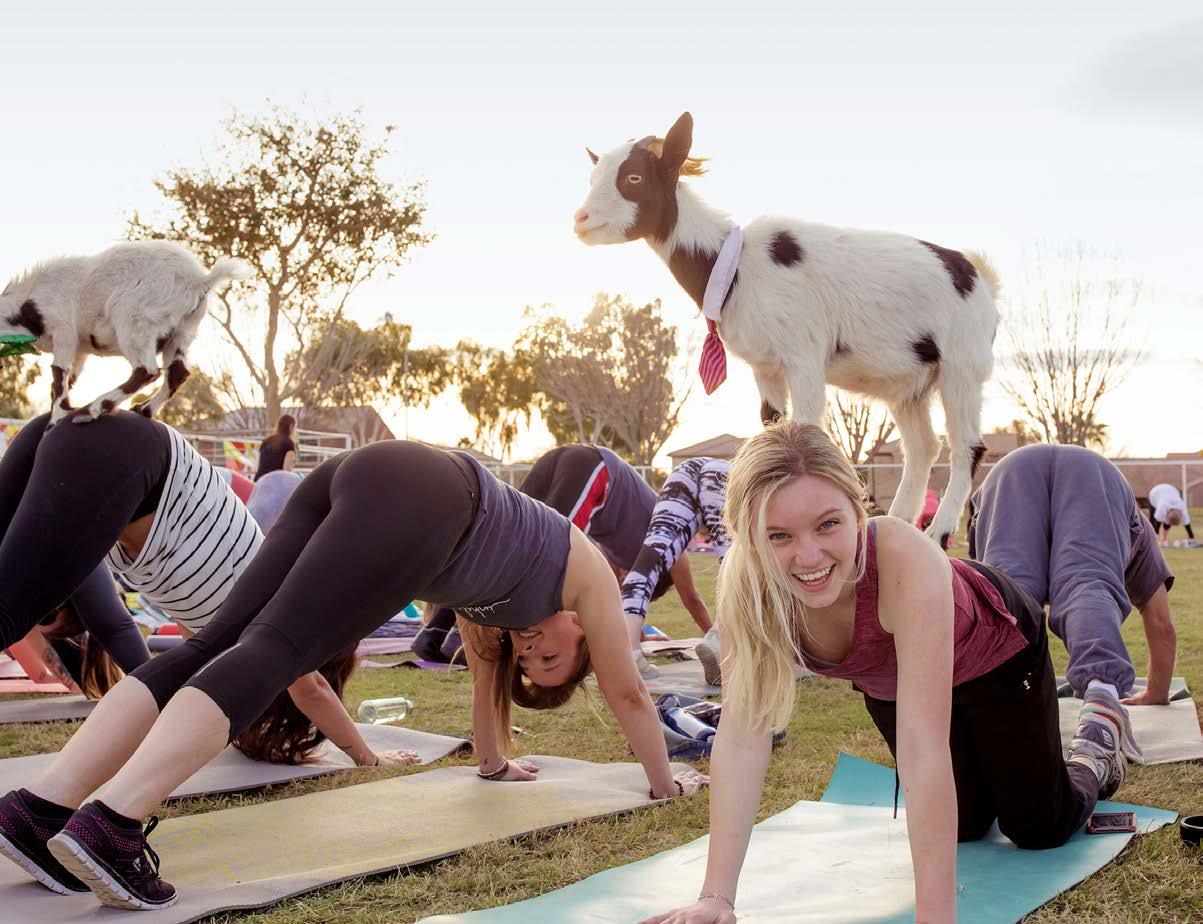
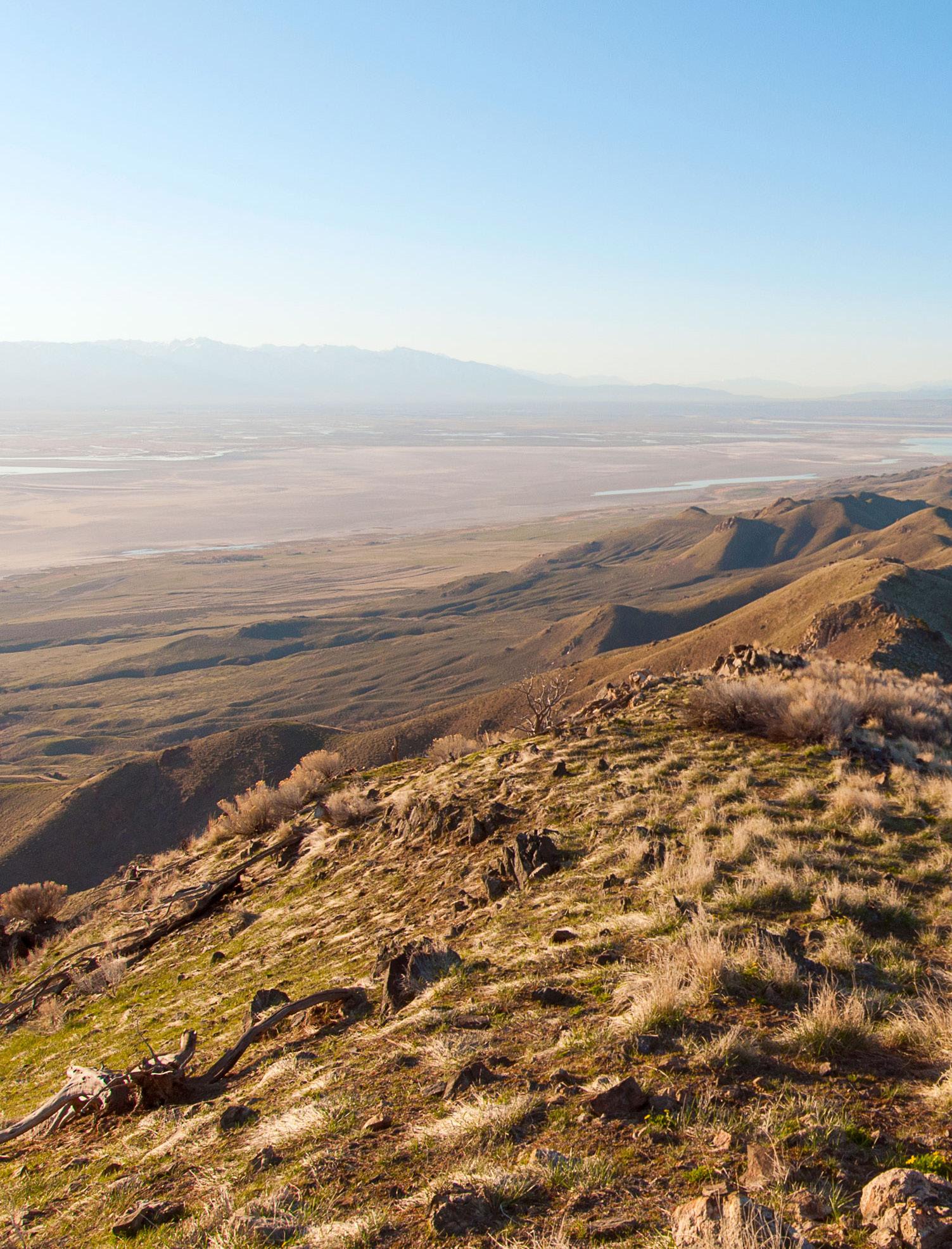
National parks may be America’s greatest idea, but they’re also crowded. Check out these hikes in state parks and other areas instead.
by tim neville


Anyone who’s ever been to Utah knows firsthand what a wonderful freak of nature the state actually is, with majestic peaks, squeeze box canyons, and a landscape full of flaming red-rock hoodoos seemingly on loan from a Warner Bros. cartoon. While the “Mighty Five” national parks get lots of well-deserved attention—Bryce Canyon, Canyonlands, Zion, Capitol Reef, and Arches—the state also has 46 state parks and countless quieter areas to explore.
where to go Tucked in the southeastern portion of the Great Salt Lake about 45 miles northwest of Salt Lake City, 42-square-mile Antelope Island is the largest of the lake’s 10 islands, mostly protected as a state park. Here you’ll find the local celebrities: as many as 700 wild, free-roaming buffalo, the largest herd in the state. Forty-five miles of trails weave across the island, too. Don’t miss a visit to the Fielding Garr Ranch, one of the oldest ranches in Utah, where buffalo often graze nearby.
what to hike Many of the trails on the island are open to mountain bikers, but not the Frary Peak Trail. Head out on this sevenmile out-and-back hikers-only route that climbs 2,329 vertical feet up a well-defined trail to afford sweeping views of the Great Salt Lake. Bison blocking the trail? Give the beast a very wide berth, and never approach one. They’re shockingly swift.
also great Escape the state’s sweltering heat with a hike in Cedar Breaks National Monument, a Bryce Canyon look-alike set more than 9,000 feet up in the mountains over Cedar City. The Spectra Point and Rampart Overlook Trails will take you about seven miles out and back among ancient bristlecone pine trees and views into a polychrome canyon. Put your camera on panorama mode and leave it there.
accessible option Antelope Island State Park has a “trail chair” at the visitor center that’s rugged, comfortable, and ready to tackle most trails, as long as you have two other people ready to assist.
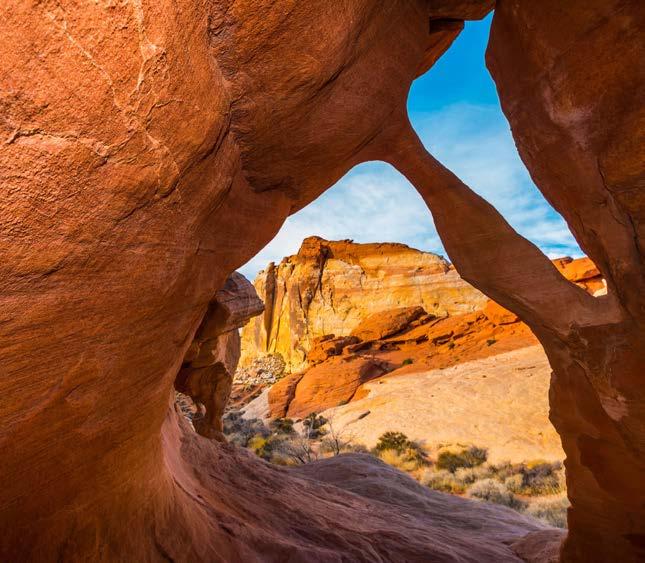
World famous for places such as Las Vegas and Reno, Nevada is also home to a vast natural terrain full of Ice Age fossils, cultural and historical sites, and nearly 30 state parks in landscapes that make for unforgettable hiking.
where to go Some 150 million years ago, shifting sand dunes slowly formed into a swatch of magnificently striated sandstone that is now the backbone of the Valley of Fire State Park. Wander among these candy cane–colored hills and you’ll find 2,500-year-old petroglyphs, petrified trees, and other marvels.
what to hike More than 20 trails wend through the park, but you should link a few of them together. The Fire Wave, White Domes, and Seven Wonders Loop is actually two relatively flat loops that run for about 3.2 miles through some of the most colorful and peculiar sandstone formations. Red, orange, and white swirls lead to slot canyons and sweeping views of odd formations such as Elephant Rock, which really does look like its namesake.
also great Looking for a place near Vegas? Head out to Red Rock Canyon National Conservation Area for a 2.1-mile hike into the cool world of Ice Box Canyon, a tight gorge where you’re certain to see rock climbers scampering up the towering sandstone walls. You may need a timed-entry permit, depending on when you visit.
accessible option The River Mountain Trails Loop east of Las Vegas runs for more than 30 miles, much of it along Lake Mead. All of it is paved.
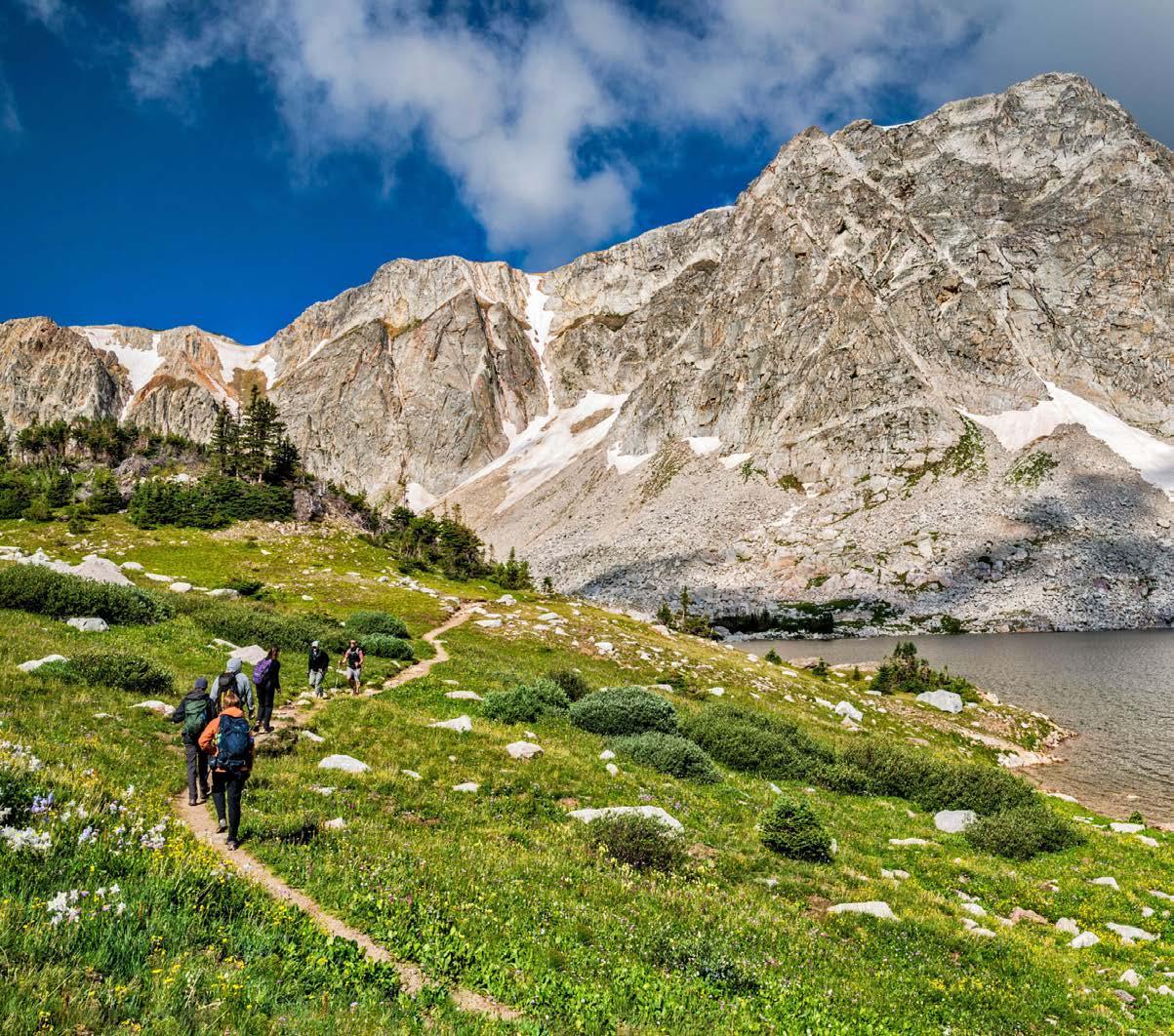
With fewer than 600,000 people living within its borders, Wyoming counts as our least populated state, with the lowest population density of all but Alaska. Translation: It’s a wonderful place to wander. Grand Teton National Park, Yellowstone National Park, and Devils Tower National Monument may be the main stage acts, but the Cowboy State also has 12 state parks and millions of acres of protected public lands.
where to go The Medicine
Bow–Routt National Forest covers nearly 3 million acres of southern Wyoming and northern Colorado—a spectacular swatch of ragged mountains, grasslands, and lakes, with airy views that you won’t have to share with the masses. Within that forest, the Snowy Range west of Laramie includes more than 40 trailheads and day-hiking areas that highlight the most photogenic parts. Go there.

what to hike At about 12,000 feet high, Medicine Bow Peak in the southern part of the state rises over twinkling alpine lakes like a giant backstop made of quartzite. The seven-mile Medicine Bow Peak and Lakes Loop takes you to the top of the peak, the highest in the range, on a well-marked trail that entails about 1,700 feet of elevation gain. One option: Start off at the Lake Marie Picnic Area about 14
miles west of Centennial on the Snowy Range Scenic Byway, and hike the loop clockwise for the most breathtaking views. Be sure to get an early start. Afternoon storms routinely roll in with little warning.
also great Glendo State Park north of Cheyenne has more than 45 miles of trails across its 22,000 acres. Try the Twenty 15 and Narrows Bluff Loop, a mostly flat 3.5-mile cir-
cuit with views over the waters of the North Platte River and the Glendo Reservoir.
accessible option Hot Springs State Park along the Bighorn River near Thermopolis does indeed have hot springs, including a free bathhouse with 104-degree water. After a soak, check out the accessible trails that offer close-up views of thermal terraces and pools.
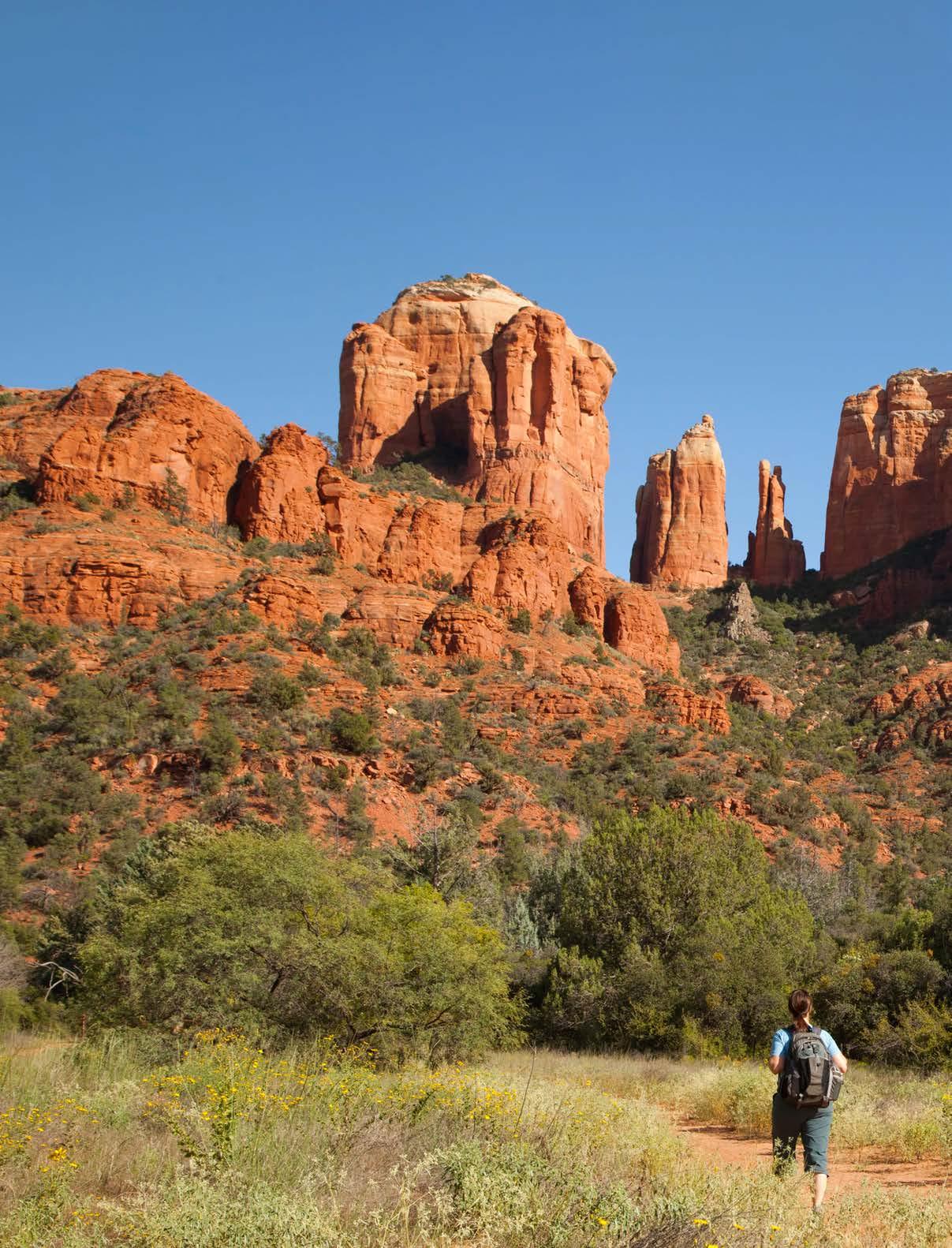

With three national parks, 34 state parks, and more than 7,000 miles of hiking trails, Arizona is hiker heaven, and we’re not even talking about the routes that go deep into the Grand Canyon. This state is much, much more than desert, with hidden oases and incredible geology. Lace up the hiking boots and be prepared to be awestruck.
where to go Sedona’s spectacular red rock domes and spires are world class by any measure and well worth a trip even if it means skipping the Grand Canyon. Hundreds of trails wend through this country, which is so inspiring that walking amidst it will leave you energized. Or is that the vortex that some believe this place to be?
what to hike No matter where you go, your choices for hikes here fall into three categories: winning, winninger, and winningest. It’s hard to go wrong with the Cathedral Rock Trail, a steep 1.2-mile outand-back trail that climbs up into the red rock spires, with jaw-dropping views of more pinnacles and ledges everywhere you look. Time your visit for sunset for the winningest of them all. Pro tip: Skip the hassle of trying to find a parking spot at the trailhead and instead catch a free shuttle from town.
also great For a somewhat longer option in similarly spectacular country, try the Devil’s Bridge Trail off Dry Creek Road. The 3.9-mile out-and-back route takes you to the namesake, a 50-foot-high sandstone arch set among heavenly views of striated mesas and buttes. The free shuttle from town takes you to the trailhead.
DAVID / SHUTTERSTOCK
accessible option Tonto Natural Bridge State Park near Payson features what’s quite possibly the largest natural travertine bridge on Earth, a 183-foot-high marvel with a 393foot opening running through it. A paved trail leads to a viewpoint overlooking it.
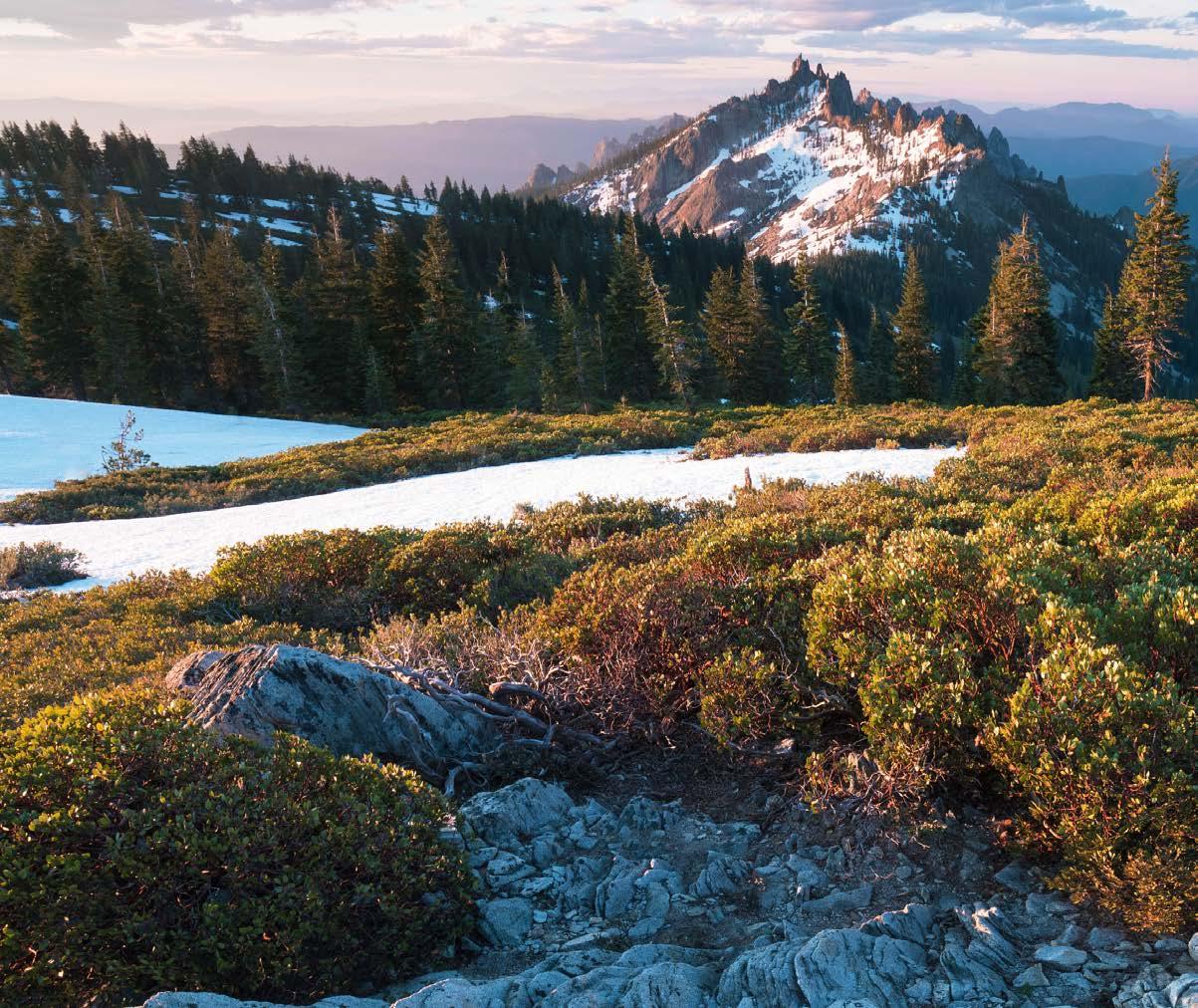
Hikers and outdoor enthusiasts need no introduction to California, home to national park gems such as Yosemite, but did you know it also has 270 state parks, the most in the country? One of them, Mount Diablo State Park, includes a vista point from which you can see the largest area of the Earth’s surface viewable anywhere outside of Africa.
where to go Castle Crags State Park, about 14 miles south of the town of Mount Shasta, features views of 6,000-foot-tall granite spires that are more than 170 million years old and scream into the sky so awesomely that they seem straight out of a fantasy
novel. Nearly 30 miles of hiking trails, including portions of the Pacific Crest Trail, punch through the park.
what to hike The 5.2-mile Crags Trail is arguably the park’s most popular and challenging route, as it takes adventurers up more than 2,000 vertical feet, close to the top of the incisor-like Castle Dome. There you’ll get a panorama of spires and icy volcanoes you’ll never forget. This is the only trail that will take you up into the granite teeth, but be forewarned: The route can get steep at times, and your neck may ache from all the looking around you’re bound to do.

also great Garrapata State Park near Carmel has it all: wildflowers, redwoods, and great views of the craggy Northern California coast. The 2.8-mile out-and-back Soberanes Canyon Trail goes through it all.
accessible option Stout Grove in Jedediah Smith Redwoods State Park features one of the most picturesque stands of redwoods on the planet, with trees that reach more than 300 feet off the forest floor. A half-mile paved loop trail takes you into the heart of it.
As the fourth-largest state but ranking just 43rd in population, Montana is something like the Alaska of the Lower 48: wild, gorgeous, and brimming with adventure. Yellowstone and Glacier National Parks are delightful indeed, but Montana also has 55 state parks that inspire.
where to go Located in far eastern Montana near Glendive, Makoshika State Park—Montana’s largest at more than 11,000 acres—is well worth the effort it takes to get there, thanks to the otherworldly, truly bizarre “badland” formations of towering, crumbling earth and sandy canyons. This area is one of the richest places on Earth for dinosaur fossils since prehistoric creatures such as the frightful Tyrannosaurus rex roamed the region when it was a tropical flood plain. what to hike Many of the trails here are less than a mile long, with hoodoos, natural bridges, and deep ravines (“coulees” in these parts) making some of them great for little kids. For a longer stroll, head out on the Gunners Ridge Trail to the Hungry Joe Overlook, a 4.4-mile out-and-back hike that takes you up along an airy ridge with panoramic views deep into the surreal landscapes. Don’t go right after a rain (when the area is very muddy), and do bring a map and water. The route isn’t always very well marked and has zero shade. Check in at the visitor center to find a guided hike with a park paleontologist, offered on Saturdays in June and July.
also great For an easy taste of Montana’s alpine grandeur, take a drive along the Beartooth Highway between Red Lodge and Cooke City, climbing to more than 10,000 feet. Or for a real challenge, take a 13-mile day hike off the highway to Black Canyon Lake, a stunning turquoise gem set below the sheer face of 11,401-foot Thunder Mountain.
accessible option Pictograph Cave State Park near Billings has a half-mile loop, much of it paved, to view rock art created as long as 2,000 years ago.

This is a land of superlatives. The country’s largest state, Alaska is also its wildest, with more rivers and forests than anywhere else. It’s the least densely populated state, but also the richest when it comes to state parks: More than 3.2 million acres of land are protected within 120 state parks, the largest swath in the country. This is big, big country with dramatic weather and fierce creatures, so hire a guide if your wilderness skills could use more work.
where to go Chugach State Park is the third largest in the state at more than 495,000 acres, which makes it actually bigger than California’s Kings Canyon National Park. And it’s right on the eastern edge of Anchorage, making Chugach one of the most accessible parks in Alaska.
what to hike Day hikes abound, of course, but you should go big and book a backpacking trip to get the full Alaskan experience. Go Hike Alaska offers three-day guided trips to Williwaw and Long Lakes, a 20-mile adventure that will take you past dazzling waterfalls, into gaping valleys, and on to lakeside campsites. Along the way you’ll look for moose, mountain goats, and, of course, bears.
also great Denali State Park shares a boundary with Denali National Park but has fewer crowds. Go Hike Alaska offers five-day backpacking trips along the K’esugi Ridge, a 30-mile traverse with fantastic views of North America’s tallest peak, 20,310-foot Denali.
accessible option In this case, give in: Take the Glacier View Loop in Kenai Fjords National Park, which runs for a mile to a viewpoint overlooking the impossibly jumbled Exit Glacier as it tumbles out of the Harding Icefield
tim neville is an avid hiker, fly-fisher, and skier living in Central Oregon. He has been writing for Via since 2012 and has also contributed to Outside, the New York Times, the Seattle Times, and CNN
